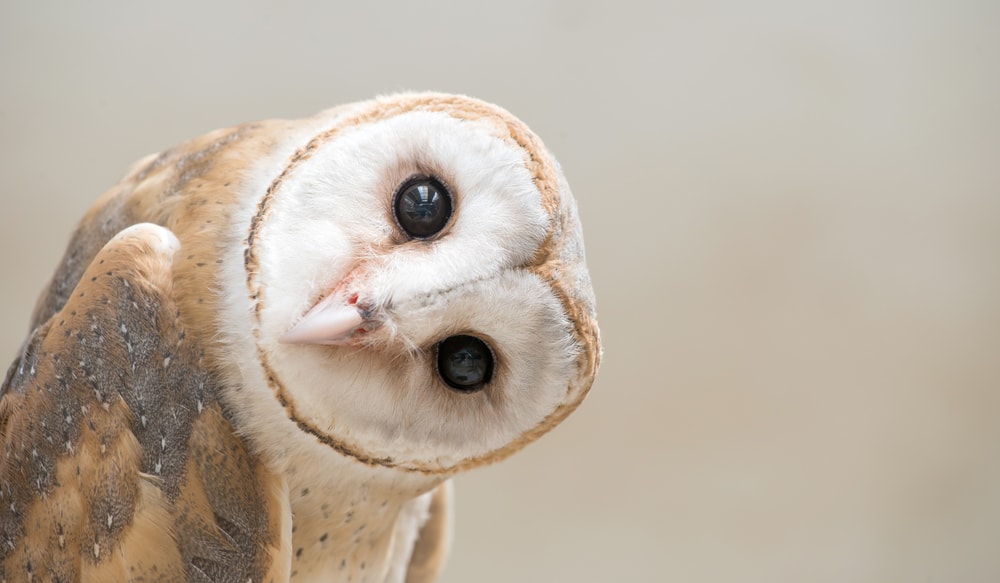
The largest owl that can be found in the state is the great-horned owl. With a wingspan upto 4.8 feet (1.4m) it is the largest owl that can be found in Texas. The smallest owl in the world is also an owl that can be found here. Measuring a sprightly 6 inches tall (15cm), they weigh a little less than a golf ball. How would an owl this small be able to find food though?
Owls are specially adapted to hunt, with concave facial discs that collect sound waves which are directed to their ears. The birds can adjust these feathers so that they can focus on different distances. This is what makes them such effective hunters, because it allows them to locate hidden prey.
Since they have to hunt, you probably think that owls are good strategists, and that must mean that owls must be pretty smart, right? You wouldn’t be wrong in thinking so. But the reality is that owls are actually not that smart.
Although owls have long been perceived to be intelligent, scientists have learned that’s not necessarily true. Approximately two-thirds of an owl’s brain is dedicated to vision and auditory senses, leaving only one-third of the brain for other functions. Many individuals also don’t score very high in cognitive tests.
They do however, live in a variety of habitats, including coniferous forests, deciduous forests, (they love dense forests and mature forests with tall trees), mountains, deserts, and plains.
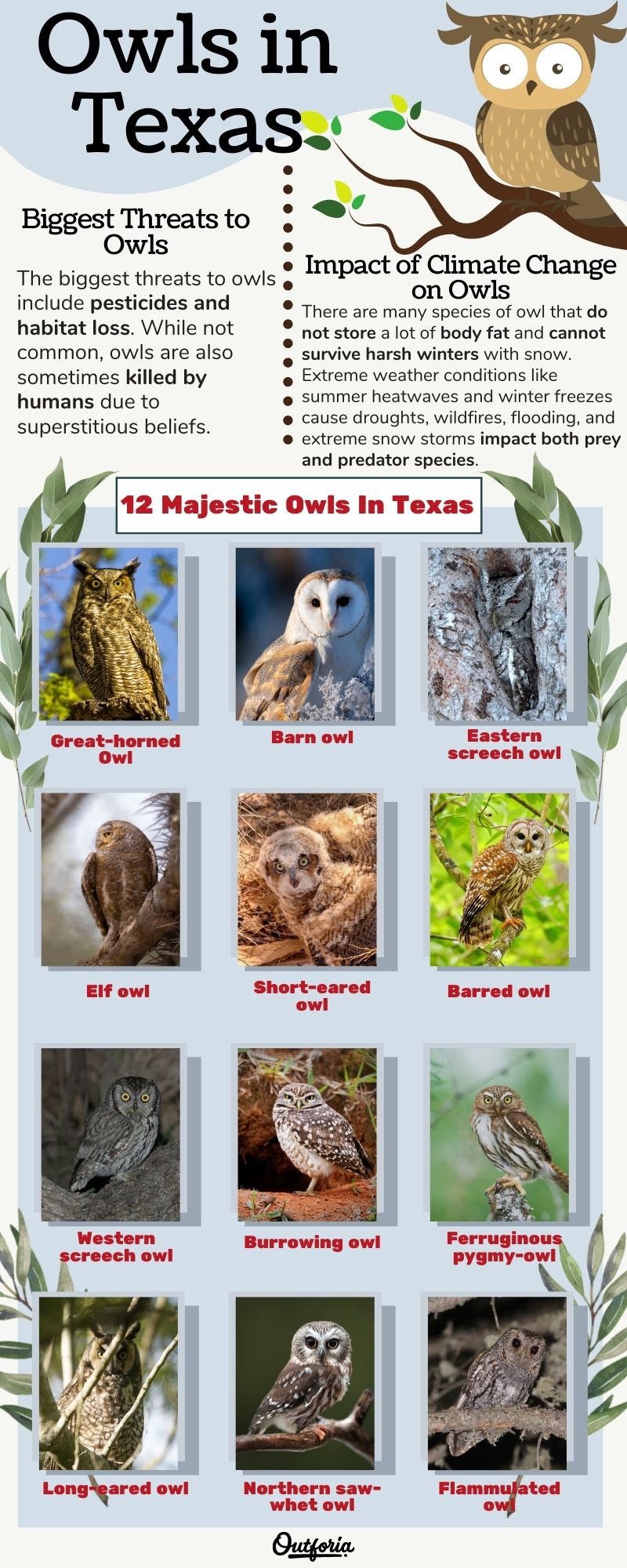
Share This Image On Your Site
<a href="https://outforia.com/owls-in-texas/"><img style="width:100%;" src="https://outforia.com/wp-content/uploads/2022/03/Owls-in-Texas-infographics-03232022.jpg"></a><br>Owls in Texas Infographic by <a href="https://outforia.com">Outforia</a>You May Also Like: Discover These 9 Different Snakes In Texas Complete Guide from Venomous to Non-Venomous
Types of Owls Found in Texas
Nineteen types of owl can be found in the United States with around 12 owls found natively in Texas alone.
1. Great-horned Owl
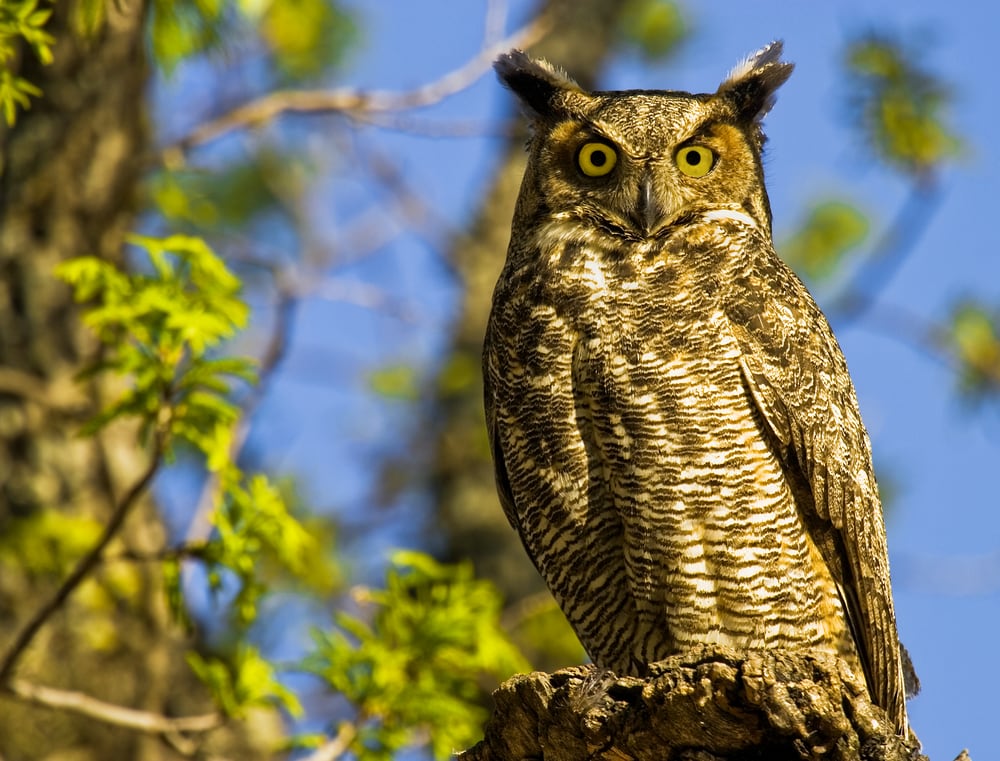
The most well-known and commonly seen owl in Texas is the great-horned owl. They are easily identifiable by the long tufts of feathers on their heads that resemble ears or horns. Largely nocturnal, they can be spotted just before dawn or after sunset accompanied by their signature ‘hoo hoos.’
Measuring almost as long as the average woman’s stride, the bodies of great-horned owls range from 18 to 25 inches (45-63cm). They can be found in places like Davis Mountains State Park and Guadalupe Mountains National Park.
Lifespans range from 5 to 15 years in the wild, and these birds are thought to mate for life.
Thanks to their broad wings, they can maneuver well and at low speeds. If unobstructed, they can hit 40 mph (64 kph). This in addition to their size allows them to hunt large prey like rabbits, squirrels, skunks, rodents, other birds, and waterfowl.
These birds lay one to five eggs with two being the most common. Their eggs are white with small bluish spots.
2. Barn owl
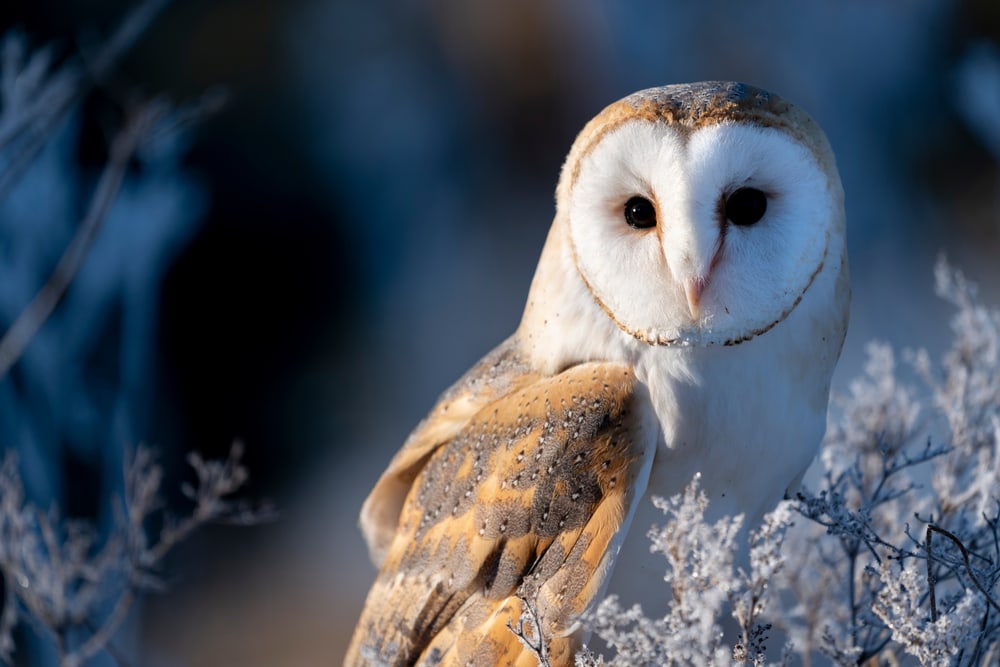
Contrary to most owl lore, in England, where barn owls often live in graveyards, one flying past an ill person’s window is said to signify approaching death. Ancient Egyptians and the Zapotec of Mexico believed the barn owl to be a symbol of death.
Giovanni Antonio Scopoli first described the species in 1769. He gave them the name Strix alba, strix being a mythical owl-like creature that fed on human flesh, and the Latin alba, meaning ‘white.’ Barn owls were later renamed Tyto alba, which comes from the Ancient Greek word Tyto. This directly translates to ‘white owl.’
Barn owls are easily identifiable by their signature heart-shaped faces and prominent facial disc. They do not hoot, instead they let out harsh screeches. They are very shy owls that make their nests in church steeples and haylofts, which is probably where they got their name from.
There are 10 subspecies that are widespread across every continent except for Antarctica. Their lifespan in the wild is 4 years and they weigh around a pound each.
Adults typically measure 13 to 15 inches (33-35cm) in length with a wingspan of 31 to 37 inches (83-93cm). Females lay between 3 to 8 eggs.
3. Eastern screech owl
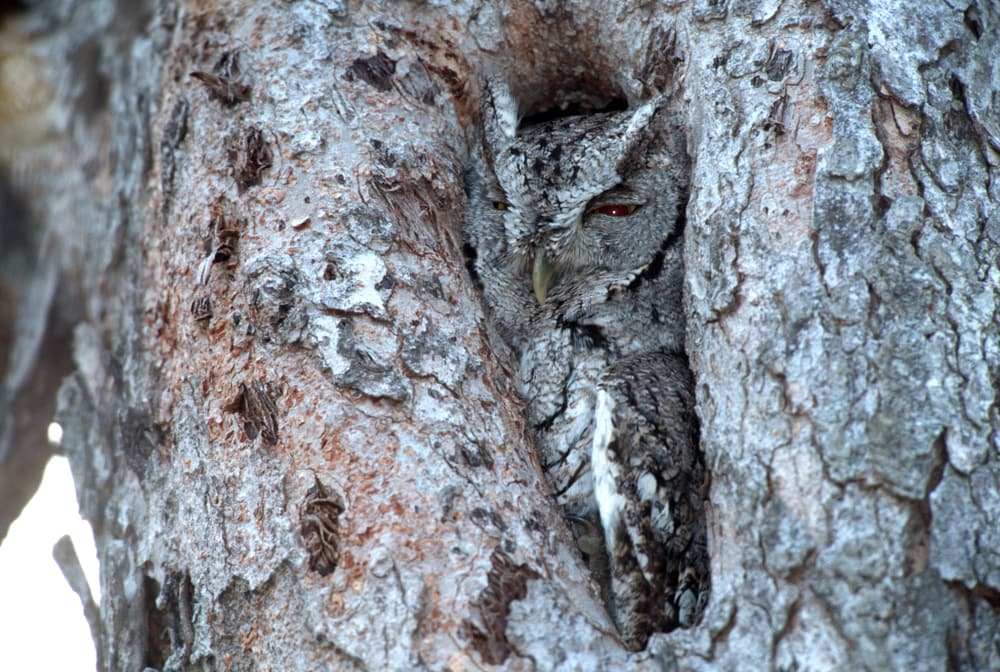
Found in the (spoiler!) eastern forests of Texas, eastern screech owls have noticeable ear tufts, with a yellow beak and eyes. They have average lifespans, with most living till around 8 years of age. Both adults and juveniles have high mortality rates.
Adults range in length from 6 ½ to 10 inches (16-25cm) with wing spans of 18 to 24 inches (45-60cm) Males in Central Texas weigh an average of 15 ½ oz (439g), while females average 6 ½ oz (184g).
Mostly nocturnal hunters, eastern screech owls hunt in twilight and during the day. Early into research about the species, they were nicknamed as ‘feathered wildcats’ due to their aggressive hunting tendencies.
Unlike a few other Texas owls that are also active during the day, eastern screech owls are completely nocturnal. Because they are so small, they are often heard more often than they are seen.
They hunt from dusk to dawn, striking quickly. They eat mostly large insects, beetles, moths, grasshoppers, crickets, crayfish, earthworms, scorpions, spiders, leeches, centipedes, small birds, lizards, small frogs, and small mammals like shrews, mice and baby rabbits.
4. Elf owl
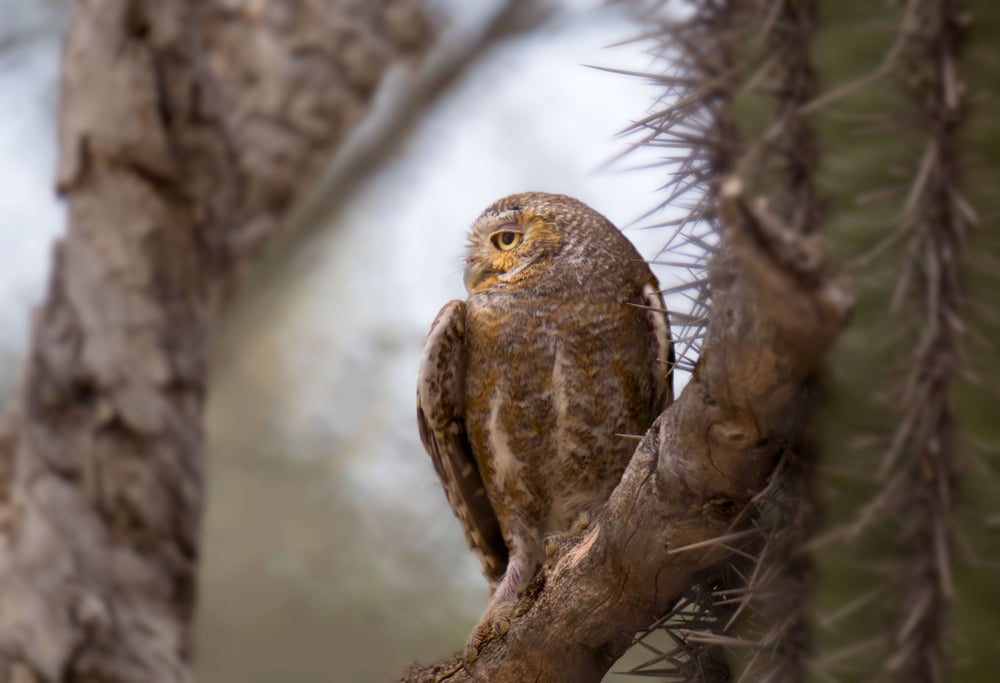
Elf owls are a summer treat in the Big Bend region and Rio Grande State Park. When handled, they play dead to encourage a looser grip, which allows them to escape.
Comparable in size to a sparrow, they are the smallest species of owl. Owing to their size they can easily fit into cacti holes made by woodpeckers and natural tree holes, which is often where they build their nests. Females lay between one to five eggs, with three being the most common.
With pale yellow eyes and white ‘eyebrows,’ some elf owl parliaments migrate into Texas so that they can breed.
In spite of their tiny size, elf owls are extremely territorial. These territories are defended by both male and females. They primarily feed on insects like crickets, centipedes, months, scorpions, small mammals, reptiles and birds.
5. Short-eared owl
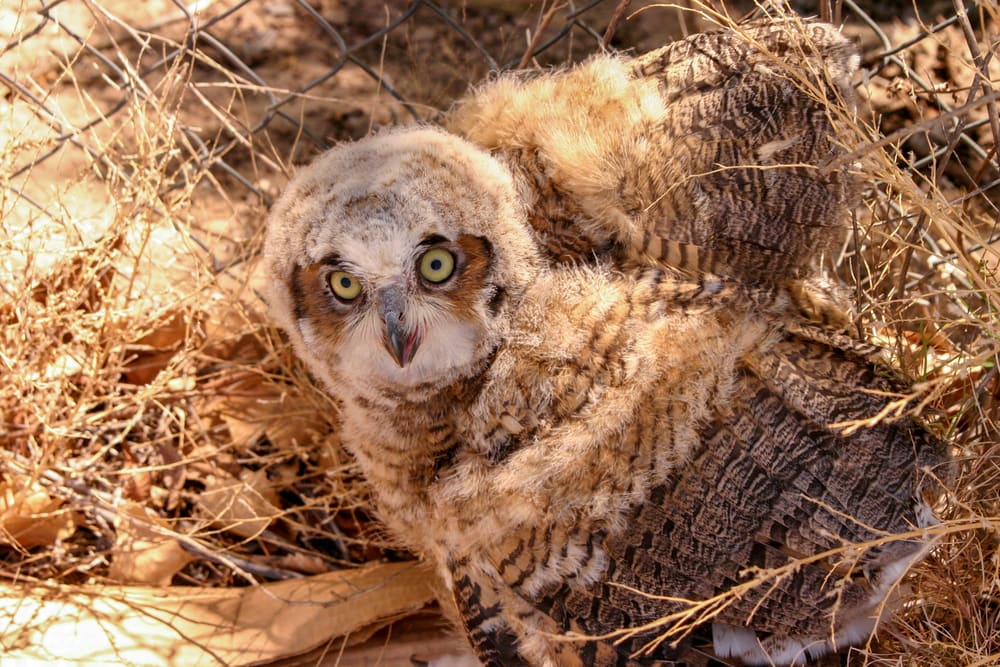
Belonging to the family of ‘eared’ owls, the short-eared owl may or may not have visible ear tufts. They have very exaggerated eye circles that give the appearance of mascara.
Often said to be very ‘moth- or bat-like’ when they fly, these owls have irregular wing beats and move suddenly back and forth.
This medium-sized owl measures 13 to 17 inches (33-43cm) in length and weighs between 7.3 to 16.8 oz. (206-476g) As with many other owl species, females are slightly larger than males and the average wingspan ranges from 33 to 34 inches.
Their call is very raspy and scratchy, and can sound like a chirp or a dog’s bark. Their feathers are a spotty tawny to brown color.
Their diet comprises voles, shrews, rats, bats, moles, muskrats, roaches, grasshoppers, beetles, caterpillars, and small birds. Their stomachs have a high pH which reduces their ability to digest bones.
6. Barred owl
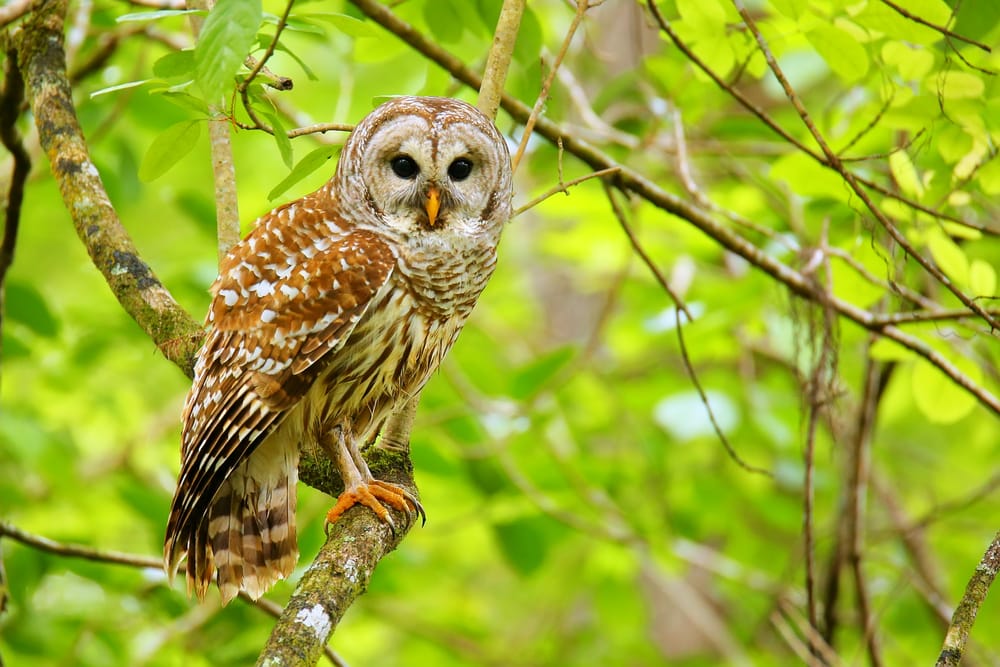
The name ‘barred’ comes from this owl’s horizontal alternating light brown and dark brown stripes on the wings, back, and tail.
Texas barred owls have a distinct hoot with eight to nine notes, that ‘Who cooks for you? Who cooks for you-all?’
This owl’s body coloration is pale ginger-cream, while the back and head are a pale brown to cinnamon color.
In terms of size, they are smaller than other types of barred owl, but they have a larger bill and feet. But compared to other owl species, they are quite large. Adults measure between 16 to 25 inches 40-63cm), with a wingspan between 38 to 49 inches (96-124cm).
They have no ear tufts but a grayish-brown face disc. While all true owls in the eastern United States have yellow eyes, the barred owl has brown eyes.
Their diet consists of small mammals like mice, squirrels, rabbits, opossums, birds, frogs, snakes, lizards, insects, and salamanders.
7. Western screech owl
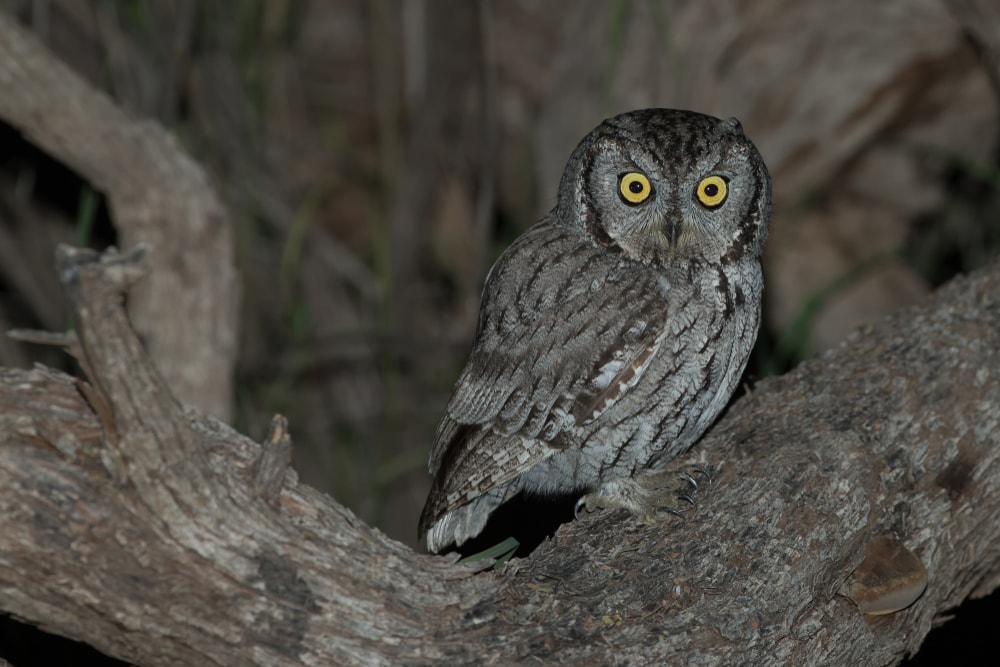
Closely related to the eastern screech owl, the western variety are small and stocky with almost no neck. They are also all gray. The only discernible difference is the color of their bill which is a very dark gray.
Ranging in size very similar to the eastern screech owl, adults average 7.5 to 10 inches (19-25cm) in length. They weigh between 5 to 6 oz 136-141g), and have wingspans of 22 inches (55cm).
Their primary call is a series of short whistles. They primarily hunt mice, birds, large insects, rats, and less frequently, Mallard ducks and cottontail rabbits.
They are mostly active at dawn, near dusk, and at night. Their feathers are dark gray or brown while their eyes and beak are yellow.
8. Burrowing owl
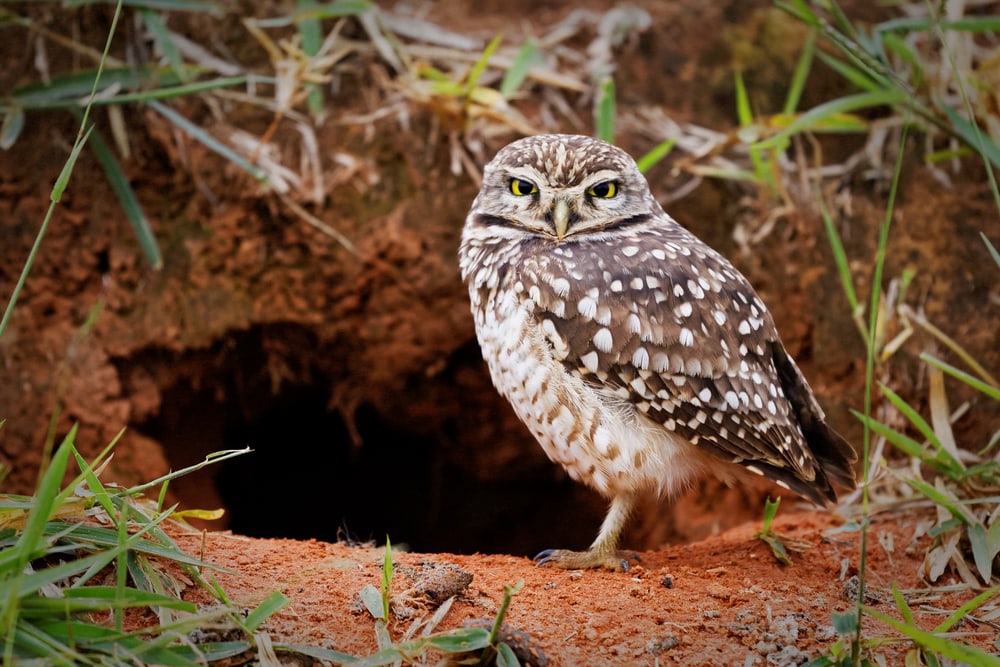
Unlike most other owls, these owls are active during the day. They hunt from dusk to dawn, with long legs that allow them to sprint as they do so. In Texas, they can be found during winter, and they breed in West Texas. Rio Bosque Park is one of the places where these owls can be spotted.
With dark yellow or gray beaks, they also have dark yellow eyes. They also have a white ‘chin’ patch, as well as ear tufts.
Living for at least 9 years in the wild, they often nest and roost in ground squirrel burrows. When threatened, they retreat into their burrows to make hissing and rattling sounds similar to that of rattlesnakes. They also expand their chin patch and bob their head when agitated.
While female owls are commonly larger than their male counterparts, there is little to no sexual dimorphism in burrowing owls. Adults are 7.5 to 11 inches long (19-27cm), with 20 to 24 inch long wingspans (50-60cm) . They are only slightly larger than American robins and weigh between 4.9 to 8.5 oz (138-240g).
Females lay eggs every one to two days laying clutches of four 12 eggs. Their diet mainly consists of mice, insects, geckos, frogs, toads, crickets, and termites. Now it is important to note that they also eat fruits and seeds which is very uncommon in other owl species.
9. Ferruginous pygmy-owl
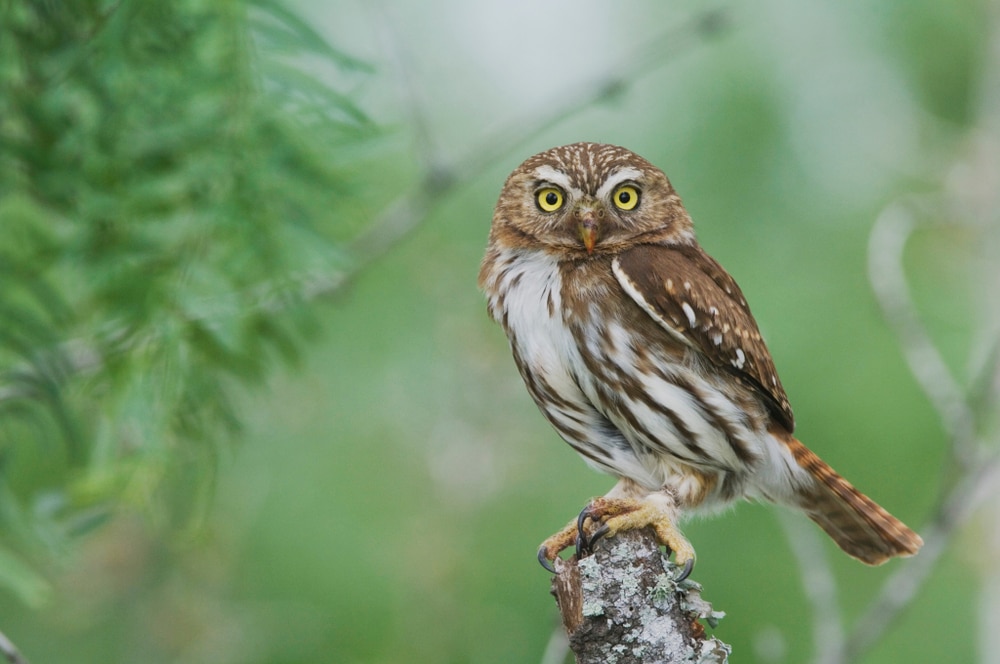
This small owl can be found in southern Texas. Primarily crepuscular (active during the twilight period), their prey includes birds, lizards, small mammals, and insects.
They measure an average of 5.9 inches (15cm) and weigh between 1.6 to 3.7 oz, (45-104g) with females weighing 0.5 to 0.7 oz (14-19g) more than males. Mother owls lay between one to seven eggs.
In comparison to its small body size, the ferruginous pygmy-owl has big feet and talons. The ferruginous sports ‘false eyes’ on the back of its head. The body varies in color from gray-brown to black and white.
Its call is a series of high, hollow hoots in one to two second intervals. When this call is used by birdwatchers, a number of small birds are attracted with the aim to mob the owls.
10. Long-eared owl
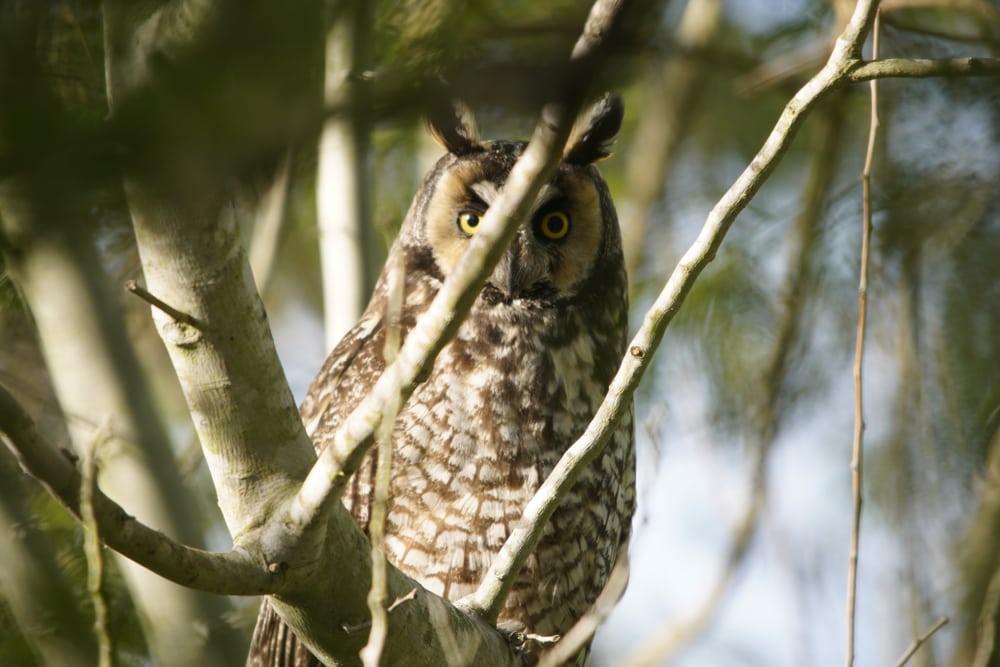
Also called the northern long-eared owl, the lesser horned owl, or cat owl, long-eared owls look like they are permanently surprised due to their long ear tufts that are closer to the middle of their heads and point straight up.
They have slim bodies and long wings, emitting low, breathy, and barking hoots. Their bodies are 12 to 16 inches in (30-40cm) length with large wingspans in relation to their size at 35 to 40 inches (88-102cm). Females are larger than males with males averaging 10.2 oz 9289g) and females averaging 11.5 oz. (326g).
The females lay 2 to 10 eggs. When vole is scarce, females will lay fewer eggs, while abundant vole results in more eggs being laid.
These owls can be found in north Texas in small groups, and they are specialized hunters, eating mostly small rodents such as voles.
Ornithologist Karel Voous considered the species to be the most vocally diverse in the Northern hemisphere, with over 20 different types of vocalizations. They have very low, soft hoots that sound like cat meows.
11. Northern saw-whet owl
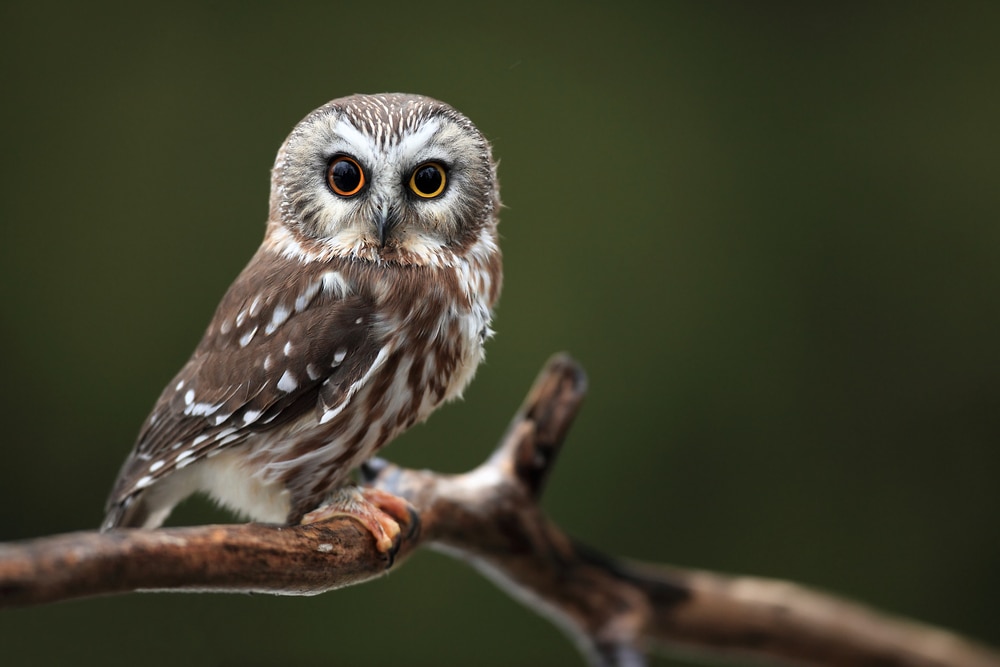
The northern saw-whet flies down to Texas only during the winter. While they can be found in small scattered groups throughout the state, they are more commonly seen in northern Texas and along the Gulf of Mexico.
Their call makes a repeated tooting sound that sounds like too-too-too-too. They mostly live in coniferous forests, but they move to mixed or deciduous forests in the winter.
A small-sized owl, adults measure 6.7 to 8.7 inches (17-22cm) long with 16.5 to 22.2 inch (41-56cm) wingspans. They are about the size of the American robin.
These owls have porphyrin pigments in their flight feathers, so when a UV light is used on the underside of the wing, the feathers glow neon pink.
Males weigh in at 2.7 oz (76g) while females weigh 3.6 oz (102g). Females lay between four to six white-colord eggs and they build their nests in tree cavities and in woodpecker holes. Unlike other owl species that are usually monogamous, female northern saw-whets will move on to find a new mate once their chicks develop feathers.
12. Flammulated owl
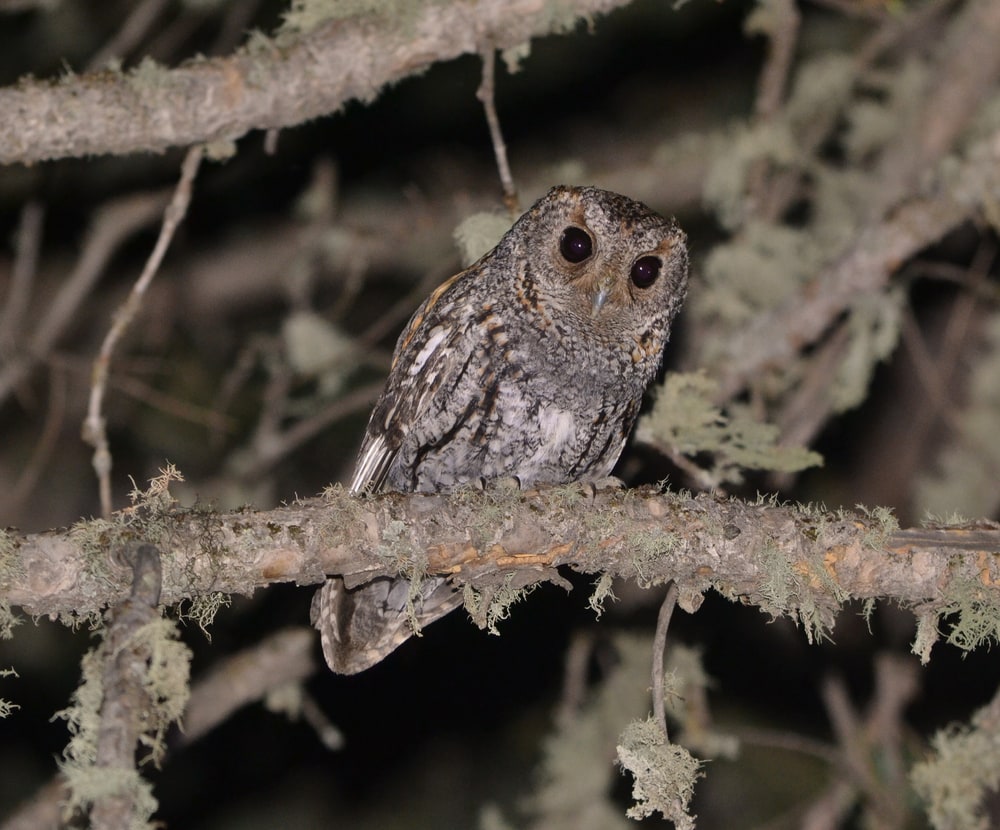
The flammulated owl’s scientific name, Psiloscops flammeolus, combines the Ancient Greek psilos meaning ‘naked’ or ‘smooth’’. The word flammeolus comes from Latin and means ‘flame-coloured,’ ‘with flame-like markings’ or ‘flammulated.’
In appearance, this owl looks like the western screech owl but is a quarter of the mass and has barely visible ear tufts. It has deep, single and double hoots.
These owls measure approximately 6 inches (15cm) long with 14 inch (35cm) wingspans. Females are larger, weighing around 2.2 to 2.3 oz,(62-64g) while males weigh around 1.8 oz.(51g).
These birds migrate to southern Texas during the winter and can be seen at Davis Mountains State Park. They primarily feed on insects, beetles, crickets, and occasionally eat shrews.
You May Also Like: Discover These 8 Owls in Florida That You Should Know About with Photos, Infographics, Facts, and more!
Biggest Threats to Owls

The biggest threats to owls include pesticides and habitat loss. While not common, owls are also sometimes killed by humans due to superstitious beliefs.
The International Union for Conservation of Nature (IUCN) lists Texas owl species as ‘Least Concern.’ But many species populations are slowly declining in some territories.
Many small rodents and insects that are considered vermin and pests have their populations managed by owls. Many farmers keep owl boxes especially for species like barn owls to keep rodent populations under control in their agricultural fields.
When owls are removed from ecosystems, rodent populations will explode as will populations of other prey that they consume.
You May Also Like: Get To Know These 15 Shore Birds in Florida complete with Photos, Infographics, Facts, and more!
Impact of Climate Change on Owls

There are many species of owl that do not store a lot of body fat and cannot survive harsh winters with snow. They are much better adapted to living in warmer and drier climates. This is why a few species migrate south during winter or live in Texas throughout the year.
Owing to the dramatically cold weather that climate change causes, there is more competition for prey, territory, and mates. Extreme weather conditions like summer heatwaves and winter freezes cause droughts, wildfires, flooding, and extreme snow storms impact both prey and predator species. These weather conditions have an impact on breeding and how much prey adults can find.
Depending on which culture you examine, owls symbolize various elements. In some cultures they signify wisdom and knowledge, while in others, they are omens of death.
In the Harry Potter series, owls make great companions and often deliver post and parcels for their magical human counterparts. Like North American owls, most British owls are nocturnal but in the wizarding world, they are active during the day and have individual personalities. They also seem able to understand English and be able to communicate.
In Ancient Greece, Athena the virgin goddess of wisdom, and her Roman counterpart Minerva, were accompanied by an owl. This is why the bird is used as a symbol of knowledge and wisdom in the Western world.
Owl in Winnie the Pooh, Archimedes in The Sword in the Stone, Friend Owl in Bambi, and Big Momma in The Fox and the Hound, were all portrayed as knowledgeable and intelligent.
While most of these representations are exaggerated, there are some characteristics that are true of them. For example, while most owls are nocturnal, many are also active during the day. They also range in size just as much as their movie counterparts.








